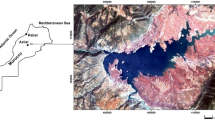Abstract
An operating ironwork is considered, which uses three different technologies for steel smelting, each of which is characterized by an individual composition of atmospheric emission, affecting the state of forest areas around the enterprise. Based on the decoding of satellite pixel photographs of forest areas, the technological mode with the least impact on forest areas is determined. This mode corresponds to the condition of the minimum area of ecological zones around the ironwork. An assessment of chemical pollution of ironworks on forest areas in the form of ecological zone areas, silva state and volumes of biomass for different parts of the forest is proposed. The mosaic of ecological zones of forest areas is determined by satellite pixel photographs of forest areas using an original algorithm for controlled cluster analysis.





Similar content being viewed by others
Notes
MMC. Sustainable development, environmental management. URL: https://mmk.ru/ru/sustainability/ecology/environmental-management/).
REFERENCES
Butusov, O.B., Leont’ev, L.I., and Meshalkin, V.P., Comprehensive assessment of metallurgical plant impact on forest areas, Vse Mater., 2009, no. 5, pp. 38–44.
Butusov, O.B., Leont’ev, L.I., Kalinnikov, V.T., and Meshalkin, V.P., Methodology for constructing a system of integral indices for assessing the metallurgical plants impact on forests, Vse Mater., 2009, no. 5, pp. 29–35.
Butusov, O.B., Leont’ev, L.I., and Meshalkin, V.P., Methodology for clustering and ranking the state of forest areas in the regions of metallurgical enterprises, Vse Mater., 2009, no. 5, pp. 26–31.
Smith, W.H., Air Pollution and Forests: Interactions between Air Contaminants and Forest Ecosystems, New York: Springer-Verlag, 1981.
Mai, X., Cheng, J., and Wang, S., Research on semi supervised K-means clustering algorithm in data mining, Cluster Comput., 2018, vol. 22, pp. 3513–3520. https://doi.org/10.1007/s10586-018-2199-7
Proc. Meeting of the International Federation of Classification Societies (IFCS), “Classification, Clustering, and Data Mining Applications,” Chicago, July 15–18, 2004, Banks D., Eds., Berlin: Springer-Verlag, 2004.
Sajana, T., Sheela Rani, C.M., and Narayana, K.V, A survey on clustering techniques for big data mining, Indian J. Sci. Technol., 2016, vol. 9, no. 3, pp. 1–12. https://doi.org/10.17485/ijst/2016/v9i3/75971
Abonyi, J. and Feil, B., Cluster Analysis for Data Mining and System Identification, Basel: Birkhauser Verlag, 2007.
Meshalkin, V.P., Butusov, O.B., and Gnauk, A.G., Osnovy informatizatsii i matematicheskogo modelirovaniya ekologicheskikh sistem: Uchebnoe posobie (Fundamentals of Informatization and Mathematical Modeling of Ecological Systems: Manual), Moscow: INFRA-M, 2010.
Chimitdorzhiev, T.N. and Efremenko, V.V., On the use of various indices of vegetation in remote sensing of ecosystems, Issled. Zemli Kosm., 1998, no. 3, pp. 49–56.
Advances in Fuzzy Clustering and Its Applications, Valente de Oliveira, J. and Pedrycz, W., Eds., New York: Wiley, 2007.
Miyamoto, S., Ichihashi, H., and Honda, K., Algorithms for Fuzzy Clustering: Methods in C-Means Clustering with Applications, Berlin: Springer-Verlag, 2008.
Borgefors, G., Distance transformations in digital image, Comput. Vision, Graph. Image Process., 1986, vol. 34, no. 3, pp. 344–371. https://doi.org/10.1016/S0734-189X(86)80047-0
Danielsson, P.E., Euclidean distance mapping, Comput. Graph. Image Process., 1980, vol. 14, no. 3, pp. 227–248. https://doi.org/10.1016/0146-664X(80)90054-4
Gao, P., Li, Z., and Zhang, H., Thermodynamics-based evaluation of various improved Shannon entropies for configurational information of gray-level images, Entropy, 2018, vol. 20, no. 1, art. ID 19. https://doi.org/10.3390/e20010019
Tsallis, C., Possible generalization of Boltzmann–Gibbs statistics, J. Stat. Phys., 1988, vol. 52, nos. 1–2, pp. 479–487. https://doi.org/10.1007/BF01016429
Sahoo, P., Wilkins, C., and Yeager, J., Threshold selection using Renyi’s entropy, Pattern Recognit., 1997, vol. 30, no. 1, pp. 71–84. https://doi.org/10.1016/S0031-3203(96)00065-9
Sparavigna, A.C., On the role of Tsallis entropy in image processing, Int. Sci. Res. J., 2015, vol. 1, no. 6, pp. 16–24.
Rapaport, D.C., The Art of Molecular Dynamics Simulation, Cambridge: Cambridge Univ. Press, 2004.
Author information
Authors and Affiliations
Corresponding author
Additional information
Translated by A. Kolemesin
About this article
Cite this article
Meshalkin, V.P., Butusov, O.B., Dovi, V.G. et al. Assessment of the Impact of the Chemical Pollution due to Metallurgical Plants on Forest Areas Using Satellite Images. Steel Transl. 51, 783–787 (2021). https://doi.org/10.3103/S0967091221110097
Received:
Revised:
Accepted:
Published:
Issue Date:
DOI: https://doi.org/10.3103/S0967091221110097




